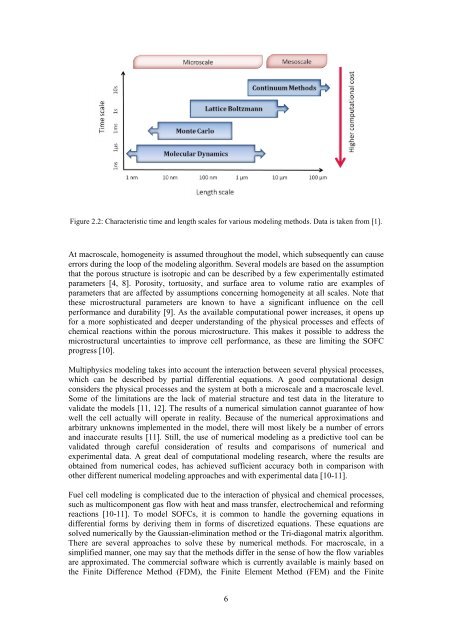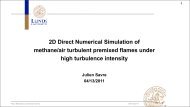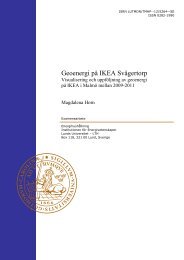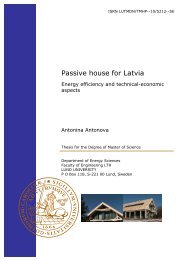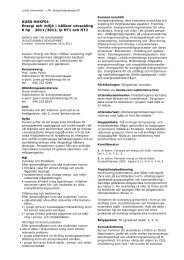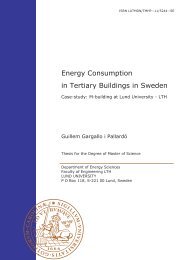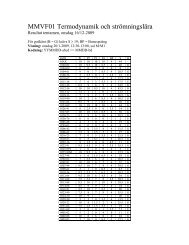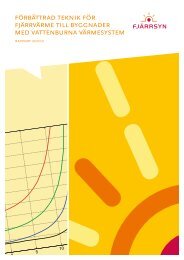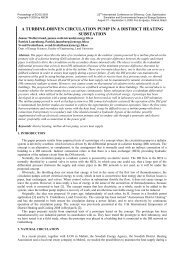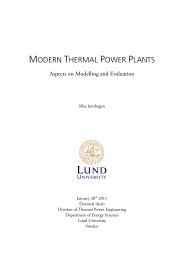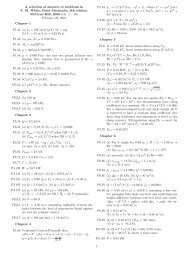Thesis for degree: Licentiate of Engineering
Thesis for degree: Licentiate of Engineering
Thesis for degree: Licentiate of Engineering
You also want an ePaper? Increase the reach of your titles
YUMPU automatically turns print PDFs into web optimized ePapers that Google loves.
Figure 2.2: Characteristic time and length scales <strong>for</strong> various modeling methods. Data is taken from [1].<br />
At macroscale, homogeneity is assumed throughout the model, which subsequently can cause<br />
errors during the loop <strong>of</strong> the modeling algorithm. Several models are based on the assumption<br />
that the porous structure is isotropic and can be described by a few experimentally estimated<br />
parameters [4, 8]. Porosity, tortuosity, and surface area to volume ratio are examples <strong>of</strong><br />
parameters that are affected by assumptions concerning homogeneity at all scales. Note that<br />
these microstructural parameters are known to have a significant influence on the cell<br />
per<strong>for</strong>mance and durability [9]. As the available computational power increases, it opens up<br />
<strong>for</strong> a more sophisticated and deeper understanding <strong>of</strong> the physical processes and effects <strong>of</strong><br />
chemical reactions within the porous microstructure. This makes it possible to address the<br />
microstructural uncertainties to improve cell per<strong>for</strong>mance, as these are limiting the SOFC<br />
progress [10].<br />
Multiphysics modeling takes into account the interaction between several physical processes,<br />
which can be described by partial differential equations. A good computational design<br />
considers the physical processes and the system at both a microscale and a macroscale level.<br />
Some <strong>of</strong> the limitations are the lack <strong>of</strong> material structure and test data in the literature to<br />
validate the models [11, 12]. The results <strong>of</strong> a numerical simulation cannot guarantee <strong>of</strong> how<br />
well the cell actually will operate in reality. Because <strong>of</strong> the numerical approximations and<br />
arbitrary unknowns implemented in the model, there will most likely be a number <strong>of</strong> errors<br />
and inaccurate results [11]. Still, the use <strong>of</strong> numerical modeling as a predictive tool can be<br />
validated through careful consideration <strong>of</strong> results and comparisons <strong>of</strong> numerical and<br />
experimental data. A great deal <strong>of</strong> computational modeling research, where the results are<br />
obtained from numerical codes, has achieved sufficient accuracy both in comparison with<br />
other different numerical modeling approaches and with experimental data [10-11].<br />
Fuel cell modeling is complicated due to the interaction <strong>of</strong> physical and chemical processes,<br />
such as multicomponent gas flow with heat and mass transfer, electrochemical and re<strong>for</strong>ming<br />
reactions [10-11]. To model SOFCs, it is common to handle the governing equations in<br />
differential <strong>for</strong>ms by deriving them in <strong>for</strong>ms <strong>of</strong> discretized equations. These equations are<br />
solved numerically by the Gaussian-elimination method or the Tri-diagonal matrix algorithm.<br />
There are several approaches to solve these by numerical methods. For macroscale, in a<br />
simplified manner, one may say that the methods differ in the sense <strong>of</strong> how the flow variables<br />
are approximated. The commercial s<strong>of</strong>tware which is currently available is mainly based on<br />
the Finite Difference Method (FDM), the Finite Element Method (FEM) and the Finite<br />
6


